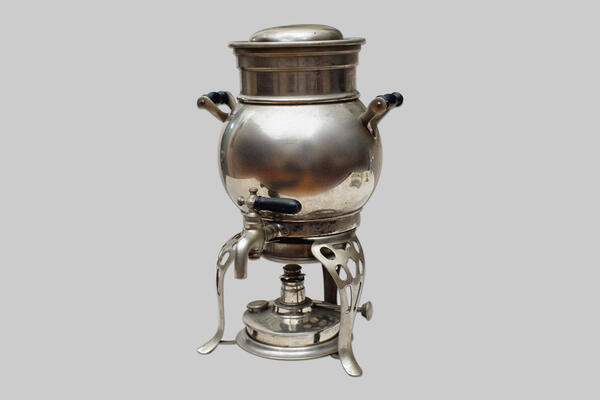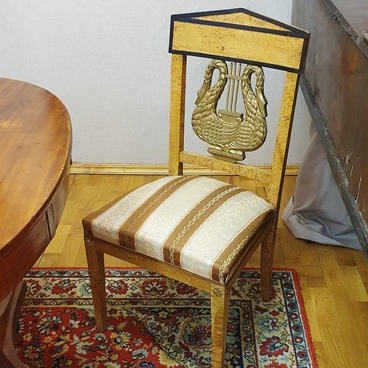A bouillotte is a set of a water pot and a spirit lamp, which is used to heat or maintain the temperature. It is believed that the prototype of the device was the Chinese kettle huǒ guō. However, the ‘fiery pot"—this is how it translates—did not have a drain tap, and the water was taken out with a special scoop.
First kettles on a spirit lamp appeared in the early 18th century. They were larger than teapots and were installed on a high stand to protect furniture from damage. Often, the kettle and spirit lamp were made at different times, and one item could be supplemented with the other as needed.
Bouillottes were used mainly to maintain the temperature of hot water; tea was brewed in them very rarely. Prior to spirit lamps, the desired temperature was achieved with special metal cylinders. They were first heated over a fire and then put into the kettle. Bouillottes were mainly made of metal, but there are also examples of earthenware and porcelain.
In the late 18th century, a more progressive device for water heating was invested: the samovar. Not only does the samovar heat the water fast to the desired temperature, but it also softens it, making it more suitable for tea-brewing. The samovar became especially popular in 19th-century Russia. In Europe, it has not received proper recognition and popularity.
After the invention of the samovAr, the bouillotte received an ironic nickname ‘the Egoist Samovar.’ However, people did not stop using the bouillotte: they often took it along on trips. The Egoist Samovar was most often used for two: for a ‘tête-à-tête.’ Special two-person tea sets were produced with this in mind.
A family invitation to tea was a special occasion. The hostess was the key figure at a tea party: she prepared and poured the tea for the guests. The tradition was born when men started gathered in coffee houses and clubs. Women, meanwhile, organized tea parties for the ladies at their homes.
Tea was served on a special table with high sides or on a tea table (which is 10-15 centimeters lower than the dinner table). A bouillotte, one or more teapots, a strainer, a sugar bowl with sugar and tongs, and cups with dishes were placed on the table. The tea reception implied certain freedom and independence of the invitees, which is why there were no servants and no change of dishes.
First kettles on a spirit lamp appeared in the early 18th century. They were larger than teapots and were installed on a high stand to protect furniture from damage. Often, the kettle and spirit lamp were made at different times, and one item could be supplemented with the other as needed.
Bouillottes were used mainly to maintain the temperature of hot water; tea was brewed in them very rarely. Prior to spirit lamps, the desired temperature was achieved with special metal cylinders. They were first heated over a fire and then put into the kettle. Bouillottes were mainly made of metal, but there are also examples of earthenware and porcelain.
In the late 18th century, a more progressive device for water heating was invested: the samovar. Not only does the samovar heat the water fast to the desired temperature, but it also softens it, making it more suitable for tea-brewing. The samovar became especially popular in 19th-century Russia. In Europe, it has not received proper recognition and popularity.
After the invention of the samovAr, the bouillotte received an ironic nickname ‘the Egoist Samovar.’ However, people did not stop using the bouillotte: they often took it along on trips. The Egoist Samovar was most often used for two: for a ‘tête-à-tête.’ Special two-person tea sets were produced with this in mind.
A family invitation to tea was a special occasion. The hostess was the key figure at a tea party: she prepared and poured the tea for the guests. The tradition was born when men started gathered in coffee houses and clubs. Women, meanwhile, organized tea parties for the ladies at their homes.
Tea was served on a special table with high sides or on a tea table (which is 10-15 centimeters lower than the dinner table). A bouillotte, one or more teapots, a strainer, a sugar bowl with sugar and tongs, and cups with dishes were placed on the table. The tea reception implied certain freedom and independence of the invitees, which is why there were no servants and no change of dishes.



